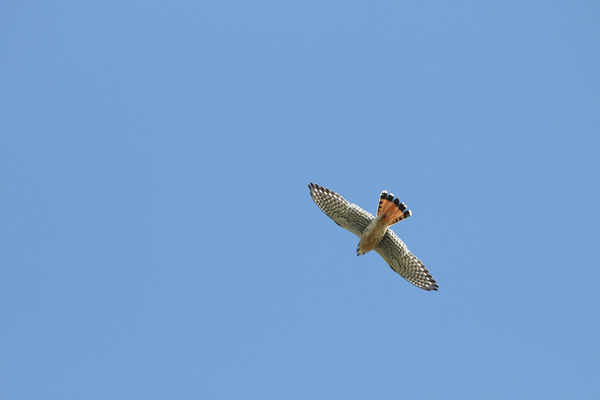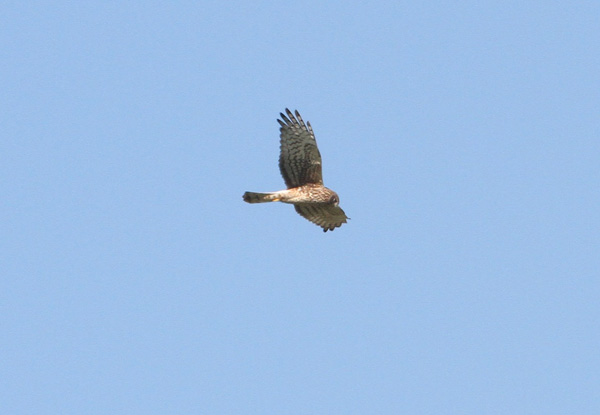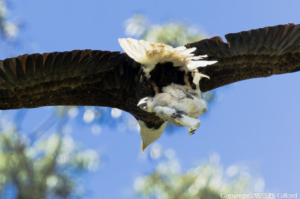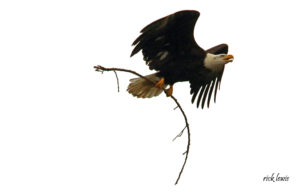Raptor expert Larry Broderick has been passionate about birds of prey since childhood. For the past two decades he’s been flying high with West County Hawk Watch, a raptor-monitoring and advocacy organization in the North Bay. We swooped in to chat with Larry about his favorite predators on the eve of this weekend’s San Francisco Bay Flyway Festival, where he’ll be leading a guided tour to observe resident and overwintering raptors with the Sonoma Land Trust.
Are you from the originally from the Bay Area?
Yes. I was born in San Francisco, lived in Pacifica for part of my childhood, then my family moved to Santa Rosa in 1970, and I never left.
What is it about raptors?
I have a lifelong admiration for all things wild, especially predator vs. prey relationships. As a child, I watched Marlin Perkins on Mutual of Omaha’s Wild Kingdom, Grizzly Adams, Marty Stauffer’s Wild America, PBS’s Nature and Jacques Cousteau. I’m a product of those guys, with some Steve Irwin (“The Crocodile Hunter”) mixed in. Let’s just say I get a little excited about hawks I see in the field.
Do you recall the moment the love affair began?
In 1975 I was ten years old, and we had some chickens in the backyard. I loved my chickens and thought they were cool . . . until one day I saw a hawk take some of my chicks. I was saddened, yet in awe, and fell in love with hawks because they were a lot cooler-looking than the chickens.
Later, coming out of high school, I needed a new direction, and really started studying raptors intently in the mid 1980s. I took environmental classes at Santa Rosa High School and studied bald eagles and other birds of prey, along with general biology courses, at Santa Rosa Junior College.

Are you trained in ornithology?
No, but I’m certified in wildlife rescue and rehabilitation. While you were all going to college I was out in the field. Self-taught works for me, but certainly my high school programs opened doors into nature that I’ve never shut.
Tell us about West County Hawk Watch.
West County Hawk Watch (WCHW) started as a group of folks who began watching overwintering birds of prey in Marin and Sonoma Counties, rural areas like Valley Ford, Two Rock, Freestone, Tomales, Fallon, and also along Highway 1. We set up a grid and searched it weekly to biweekly in the fall and winter for a decade, from 1996 to 2006. Why? Well, there was a lot of rough-legged and ferruginous hawk activity but not a lot of documentation of them in the region.
We also reached out to ranchers and farmers to explain the value of hawks and eagles from an environmental standpoint. There was a lot happening out there with predation of sheep: The work of coyotes or cougars is “cleaned up” by hawks and eagles, and so birds of prey look like culprits but they aren’t.
Anyhow Jesse House, a founding partner in the group, created a website in 1997 where raptor fans can share hawk-related photos, stories and information. Right now WCHW has several projects going on.
Can you describe some of those?
The Jenner Headlands Preserve Raptor Migration Project focuses on the annual fall migration of raptors over the Jenner Headlands. It’s a mini GGRO-style count that runs two to three days a week from September through October, at the height of raptor migration. We also document overwintering ferruginous and rough-legged hawks as well as nearby resident bald and golden eagles.
The Jenner Bald Eagle Watch has been monitoring and documenting bald eagles in the region, the ones that have been seen around Jenner for the last five or six years.
North Bay Raptor Education and Conservation, (NREC), is the educational and action arm of West County Hawk Watch. NREC monitors nesting threats, threats to migratory routes, and overwintering habitats. We do presentations on birds of prey identification and we touch briefly on natural history and current and potential threats to raptors. Right now we’re really focused on wind and solar energy to make sure it’s done right. We’ve partnered with Madrone Audubon and Sonoma Birding on this important issue, as solar and wind energy companies are asking for “take permits” to justify the killing of our “protected” birds of prey.

What are the most important threats facing raptors now?
Locally, there are the wind turbines at Altamont and out in Solano County near Rio Vista. I If you’re gonna do renewables, do it right! The technology’s out there. Our group is also focused on independent inspection of these renewable sites. Other threats? There’s global warming: We’ve seen a lot of strange stuff going on with species distributions over the last decade, likely due to rising temperatures and sea levels, and even more, from the ongoing drought. Then there’s cats. House cats that spend most of their time outdoors and feral cats kill millions of birds a year.
What can we do about all of these threats? What is your group doing?
Get educated, empower your people, teach, learn, grow. Our group is simply a social network of four dozen hardcore raptor conservationists and interpretive specialists and a couple hundred more members who promote birding ethics and document birds of prey.
The biggest thing our group does is take people out on hikes and walks and show them the hawks in these ecosystems and explain the importance of a balanced ecosystem. If the hawks are doing well it’s a sign the ecosystem is doing fine.
What’s are some of your favorite raptor projects and activities ?
The Golden Gate Raptor Observatory at the Marin Headlands: The director there, Allen Fish, has always been a mentor. I also love partnering with land trust groups like Sonoma Land Trust and Solano Land Trust, and getting out on the land, away from cars and cities. There are lots of things to see on these land trust properties, which are often teeming with hawks. I want to get people out there to see nature playing out on a daily basis and nothing exemplifies that more than the predator vs. prey drama that unfolds every day in the world of raptors.
What’s your favorite place to watch raptors locally?
My favorite place to watch raptors is Lower Klamath National Wildlife Refuge in southern Oregon. But locally? Lynch Canyon and Rush Ranch in Solano County. In Sonoma there’s Jenner Headlands, Sonoma Baylands, Skaggs Island, and Sears Point Ranch. Then, of course, there’s the incredible Golden Gate Raptor Observatory in Marin, and in the Valley, there’s the Sacramento Wildlife Refuge Complex and Grey Lodge.
When’s the best time to see them?
Migration used to peak the third week of September, but now it seems it be coming a little later, even into October. I tend to hawk-watch hard from September 1st to March 14th. That said, the best time is from Sept 14th to Nov 1st. But if it’s a good winter in terms of prey and the hawks are in the region it’s basically good though February. Come March most guests have headed back to their northern territories and breeding grounds.
Why do you enjoy watching them?
The sense of freedom, power, grace, and beauty I get from observing them. And again, just the fact that birds of prey are a great environmental barometer and when something goes wrong with them, we need to be concerned. We’re at the top of the food chain, and if something in the environment is killing the canary in the coal mine, well? How long until it’s our turn? Also the sheer daily struggle to survive; these hawks and falcons need to catch prey often to maintain their peak health and performance. I’m always amazed to hear banders tell me about hawks they banded that are now 28 years old.
At one time I was at a very low point in my life; my companion left me more then once. So I gave up on love for a while. I got real deep into wilderness and wildlife studies. The hawks were always there, I saw them every day, everywhere, they were a mainstay and gave me focus. I learned about them and then I learned about myself.
Upcoming Raptor Tours with Larry
Join Larry for a Valentine-themed presentation on the love lives of raptors, Thursday evening, February 12 at 7:30 PM at the Laguna Foundation Education Center in Santa Rosa: “Raptors in Love: Pair Bonding, Courtship & Natural History“.
Larry will also lead a guided raptor walk this coming Sunday (Feb. 15) at Sears Point Ranch, part of the San Francisco Bay Flyway Festival. Search for resident and migrant raptors and learn to identify different species.
West County Hawk Watch
For a complete schedule of West County Hawkwatch events, visit the group’s website at: http://westcountyhawkwatch.blogspot.com or its Facebook page. WCHW also has two message boards on yahoo, Headlandhawks and NorthBayHawks (both @yahoogroups.com)





